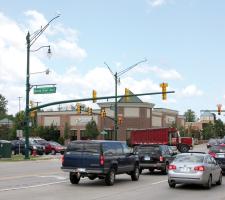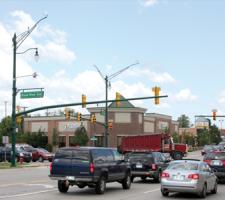
Shelley Row, Director of the ITS Joint Program Office, US Department of Transportation, details the new five-year ITS Strategic Research Plan
Imagine a world where vehicles of all types can talk to each other in order to reduce or eliminate crashes, where vehicles can talk to traffic signals to eliminate unnecessary stops, where travellers can get accurate travel time information about all modes and route options, and where transportation managers have data which allows them to accurately assess multimodal transportation system performance.Connectivity is the key to transforming this imagined world into a real one: connectivity with and between vehicles; between vehicles and roadway infrastructure; and among vehicles, infrastructure and passengers' wireless consumer devices.
But these kinds of connectivity won't happen without research that investigates key questions and is guided by a well-disciplined approach. The
A plan that works how?
The core of the ITS Strategic Research Plan is IntelliDriveSM, a multimodal research initiative that aims to create safe, interoperable connectivity among vehicles, infrastructure and passengers' wireless devices. The plan provides the foundational research necessary to reach implementation of IntelliDrive and focuses on key research questions related to applications, technology and policy that must be answered (see Panel).The word 'vehicles' refers not just to passenger cars, but also to trucks and transit vehicles. The research outlined in the plan includes integration of technology into all these platforms, as well as development of applications that support personal vehicle, commercial vehicle and transit needs. The feasibility of integrating heavy and light rail and maritime applications into the system will also be examined.
In addition, international cooperation and coordination are important aspects of the plan. Through a recently signed Joint Declaration of Intent between the USDOT and the
A plan to achieve what?
There are three main elements to the plan: safety, mobility and the environment.There are over 5.8 million crashes per year on US roadways, resulting in 37,000 deaths annually. IntelliDrive safety applications are designed to increase situational awareness and reduce or eliminate crashes through Vehicle-to-Vehicle (V2V) and Vehicle-to-Infrastructure (V2I) data transmission that supports driver advisories, driver warnings and vehicle and/or infrastructure controls.
Traffic congestion is an $87.2 billion annual drain on the US economy, with 4.2 billion hours spent sitting in traffic. IntelliDrive mobility applications provide a connected, data-rich travel environment in which the network captures real-time data from equipment located onboard vehicles and within the infrastructure. The data are transmitted wirelessly and used by transportation managers in a wide range of dynamic, multimodal applications to manage the transportation system for optimal performance.
Tailpipe emissions from vehicles are the single largest human-made source of CO2, nitrous oxides (NOX) and methane. Stop-and-go traffic results in 2.8 billion gallons of fuel being wasted every year. IntelliDrive environmental applications both generate and capture environmentally relevant real-time transportation data, and use these data to create actionable information to support and facilitate green transportation choices.
A plan developed how?
The plan was developed using a process that involved stakeholders within and outside the USDOT. Last spring, input was sought from the ITS community through a Request for Information (RFI) and an open public meeting. Multimodal teams from within the USDOT developed various aspects of the plan, based on stakeholder input.A plan using what resources?
The ITS Strategic Research Plan assumes that the USDOT's ITS research programme will receive the same level of funding as previous years: $110 million annually for five years. In 2010, up to $77 million will be dedicated to ITS research, $49 million of which will be devoted to wireless connectivity. All research activities include "go/no go" decision points at major milestones where the expected costs and benefits of additional research will be assessed.A plan to do what, exactly?
The ITS Strategic Research Plan has four main components: IntelliDrive research, mode-specific research, exploratory research and cross-cutting support.In order for IntelliDrive to be implemented in the real world, key applications, technology and policy issues must be addressed.
Application area research is intended to explore and validate the effectiveness of potential applications. And, as part of the entire IntelliDrive programme, human factors research will be conducted to examine how to use technology to increase safety without creating driver distraction.
There are five IntelliDrive application research areas. The first is concerned with V2V and V2I communications for safety. These, based on 5.9GHz Dedicated Short-Range Communications (DSRC), are designed to increase drivers' situational awareness and reduce the number and severity of crashes by advising or warning drivers of dangerous situations. Research in V2V for safety is designed to validate the effectiveness of safety applications in order to support a decision by the
Real-time data capture and management research will assess what traffic, transit and freight data are available today from various sources, and consider how to integrate data from vehicles acting as 'probes' in the system.
Research into dynamic mobility applications will develop and then demonstrate applications that use data collected via both DSRC and non-DSRC means and integrate these data with those collected from traditional sources, such as in-pavement sensors. These applications will enable dynamic decision-making; travellers would be able to choose routes and travel modes for the fastest and most environmentally friendly trip and transportation managers would be able to anticipate - and address - problems in the network before they happen.
Road weather management research will consider how vehicle-based data on current weather conditions can be used by travellers and transportation agencies to enable decision-making that takes current weather conditions and future weather forecasts into account.
ITS Strategic Research Plan,
2010-2014: key research questions
Applications
• Are applications available and benefits validated?
• What is the minimum infrastructure needed for the greatest benefit? How much, where, when and what type?
• What is the degree of market penetration required for effectiveness?
Technology
• Is the technology stable, reliable, secure and interoperable?
• Are international standards available to ensure interoperability?
Policy
• What policies, governance and funding are required for sustainability?
• How to address public concerns for privacy and ensure that applications do not cause driver distraction?Finally, Applications for the Environment: Real-time Information Synthesis (AERIS) research will explore how anonymous data from vehicles can be combined with other environmental data.
A significant body of research in IntelliDrive policy and non-technical issues is also planned. This work is intended to answer the non-technical questions needed to enable wide-scale deployment. The focus is on defining deployment scenarios, financing and governance options, and on identifying means of addressing liability, privacy, data ownership and other institutional issues.













